The Leofric Missal is an illuminated manuscript, not strictly a conventional missal, from the 10th and 11th century, now in the Bodleian Library at Oxford University where it is catalogued as MS Bodl. 579.
The Leofric Missal is an illuminated manuscript, not strictly a conventional missal, from the 10th and 11th century, now in the Bodleian Library at Oxford University where it is catalogued as MS Bodl. 579.
The origins of the manuscript date to around 900 AD when a sacramentary was produced in Lotharingia. Anglo-Saxon parts were added to the manuscript during the 10th and 11th centuries, including a calendar of church feasts as well as other information on celebrating the Mass, and some legal records in Old English. The last of these additions date to the episcopate of Leofric, who was Bishop of Exeter from 1050 to 1072. [1]
The Missal gained its name from the dedication on the first folio (f) that the book was given by Leofric to his cathedral. This is written in an 11th-century scribal hand, that has been identified as originating at Exeter Cathedral. [2]
The Missal consists of three basic sections. The first, named "A" by one of the editors of the manuscript, F. E. Warren, is the sacramentary, probably created in the last half of the ninth century. It contains a large initial (f 154 verso (v)) with human and animal heads and interlace that is thought to have been added in England in the first half of the 10th century. [3]
Warren called the second section "B" and identified it as 21 folios of material relating to a calendar, other computus-related material, and four pages of illustrations on both sides of folios 49 and 50. [2] These illustrations, which are full-page and mostly drawings in several colours of ink, were added around 970 in England in a different style to the initial in section A. They are an early instance of the influence from the school of Reims that was part of the formation of the Winchester style through works like the Utrecht Psalter. [4] Their style has been compared to the slightly earlier Winchester manuscript, the Benedictional of St. Æthelwold, though the miniatures there are mostly fully painted. [5] Folio 49r depicts the Hand of God giving the paschal cycle, followed by pages showing standing figures of Vita and Mors ("Life" and "Death"), illustrating the Apuleian Sphere, a method of divination to discover if a patient would live or die, that ultimately originated in Coptic Egypt. Folio 50 v has diagrams with decorations and a bust in a roundel showing the calculation of the date of Easter. There is decoration, in one case a full border, of acanthus foliage, and all the drawings are badly faded. [6] [7] The entire "B" section appears to have originated at Glastonbury Abbey, and seems to have formed a coherent whole. The lack of mention of Edward the Martyr, who died in 979, would place the addition of this material before that date. [2]
The rest of the manuscript, which is named "C" by Warren, is a collection of a variety of texts written by over thirty different scribes throughout the 10th and 11th centuries. The information relates to the Mass, manumissions, and other notes and were all written by English scribes. The "C" information is not in one coherent block, as it is not only added at the beginning and the end of the manuscript, but also occupies blank spaces throughout the other two sections. [6]
Warren suggested that section "A" was brought by Leofric to England in the 1040s when Leofric returned from the Continent. Warren felt that Leofric then added "B", which was a pre-existing manuscript that Leofric acquired, and "C", which were notes that Leofric had accumulated. Other scholars, however, including Robert Desham, feel that section "A" was in England by about 940 or so. Desham then argues that "B" was specifically composed before 979 to bring a foreign and older sacramentary up to date. "C", according to Desham, was composed over time during the 10th and 11th centuries, and thus Leofric had little hand in the creation of the Missal. [6]
Old English literature refers to poetry and prose written in Old English in early medieval England, from the 7th century to the decades after the Norman Conquest of 1066, a period often termed Anglo-Saxon England. The 7th-century work Cædmon's Hymn is often considered as the oldest surviving poem in English, as it appears in an 8th-century copy of Bede's text, the Ecclesiastical History of the English People. Poetry written in the mid 12th century represents some of the latest post-Norman examples of Old English. Adherence to the grammatical rules of Old English is largely inconsistent in 12th-century work, and by the 13th century the grammar and syntax of Old English had almost completely deteriorated, giving way to the much larger Middle English corpus of literature.
Leofric was a medieval Bishop of Exeter. Probably a native of Cornwall, he was educated on the continent. At the time Edward the Confessor was in exile before his succession to the English throne, Leofric joined his service and returned to England with him. After he became king, Edward rewarded Leofric with lands. Although a 12th-century source claims Leofric held the office of chancellor, modern historians agree he never did so.
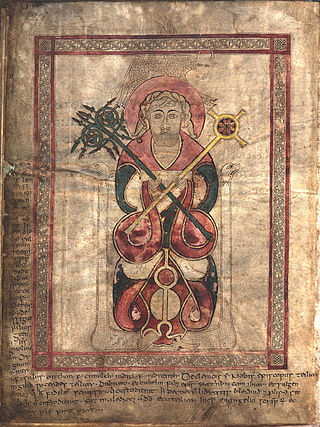
The Lichfield Gospels is an 8th-century Insular Gospel Book housed in Lichfield Cathedral. There are 236 surviving pages, eight of which are illuminated. Another four contain framed text. The pages measure 30.8 cm by 23.5 cm. The manuscript is also important because it includes, as marginalia, some of the earliest known examples of written Old Welsh, dating to the early part of the 8th century. The art historian Peter Lord dates the book at 730, placing it chronologically before the Book of Kells but after the Lindisfarne Gospels.
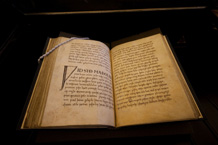
The Exeter Book, also known as the Codex Exoniensis or Exeter Cathedral Library MS 3501, is a large codex of Old English poetry, believed to have been produced in the late tenth century AD. It is one of the four major manuscripts of Old English poetry, along with the Vercelli Book in Vercelli, Italy, the Nowell Codex in the British Library, and the Junius manuscript in the Bodleian Library in Oxford. The book was donated to what is now the Exeter Cathedral library by Leofric, the first bishop of Exeter, in 1072. It is believed originally to have contained 130 or 131 leaves, of which the first 7 or 8 have been replaced with other leaves; the original first 8 leaves are lost. The Exeter Book is the largest and perhaps oldest known manuscript of Old English literature, containing about a sixth of the Old English poetry that has survived.
In the Western Church of the Early and High Middle Ages, a sacramentary was a book used for liturgical services and the mass by a bishop or priest. Sacramentaries include only the words spoken or sung by him, unlike the missals of later centuries that include all the texts of the mass whether read by the bishop, priest, or others. Also, sacramentaries, unlike missals, include texts for services other than the mass such as ordinations, the consecration of a church or altar, exorcisms, and blessings, all of which were later included in Pontificals and Rituals instead.

The Vespasian Psalter is an Anglo-Saxon illuminated psalter decorated in a partly Insular style produced in the second or third quarter of the 8th century. It contains an interlinear gloss in Old English which is the oldest extant English translation of any portion of the Bible. It was produced in southern England, perhaps in St. Augustine's Abbey or Christ Church, Canterbury or Minster-in-Thanet, and is the earliest illuminated manuscript produced in "Southumbria" to survive.

The Benedictional of St Æthelwold is a 10th-century illuminated benedictional, the most important surviving work of the Anglo-Saxon Winchester School of illumination. It contains the various pontifical blessings used during Mass on the differing days of the ecclesiastical year, along with a form for blessing the candles used during the Feast of the Purification. The manuscript was written by the monk Godeman at the request of Æthelwold, Bishop of Winchester.

Anglo-Saxon art covers art produced within the Anglo-Saxon period of English history, beginning with the Migration period style that the Anglo-Saxons brought with them from the continent in the 5th century, and ending in 1066 with the Norman Conquest of England, whose sophisticated art was influential in much of northern Europe. The two periods of outstanding achievement were the 7th and 8th centuries, with the metalwork and jewellery from Sutton Hoo and a series of magnificent illuminated manuscripts, and the final period after about 950, when there was a revival of English culture after the end of the Viking invasions. By the time of the Conquest the move to the Romanesque style is nearly complete. The important artistic centres, in so far as these can be established, were concentrated in the extremities of England, in Northumbria, especially in the early period, and Wessex and Kent near the south coast.

The Vercelli Book is one of the oldest of the four Old English Poetic Codices. It is an anthology of Old English prose and verse that dates back to the late 10th century. The manuscript is housed in the Capitulary Library of Vercelli, in northern Italy.
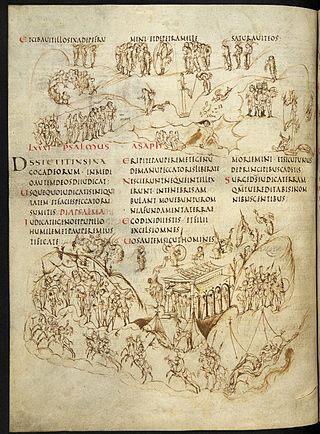
The Utrecht Psalter is a ninth-century illuminated psalter which is a key masterpiece of Carolingian art; it is probably the most valuable manuscript in the Netherlands. It is famous for its 166 lively pen illustrations, with one accompanying each psalm and the other texts in the manuscript. The precise purpose of these illustrations, and the extent of their dependence on earlier models, have been matters of art-historical controversy. The psalter spent the period between about 1000 to 1640 in England, where it had a profound influence on Anglo-Saxon art, giving rise to what is known as the "Utrecht style". It was copied at least three times in the Middle Ages. A complete facsimile edition of the psalter was made in 1875, and another in 1984 (Graz).
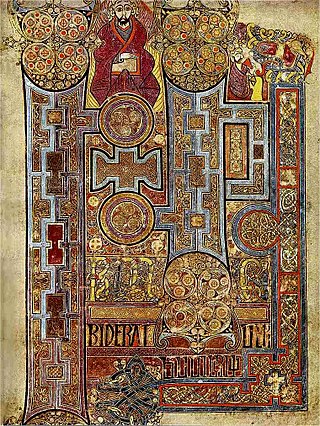
Insular art, also known as Hiberno-Saxon art, was produced in the post-Roman era of Great Britain and Ireland. The term derives from insula, the Latin term for "island"; in this period Britain and Ireland shared a largely common style different from that of the rest of Europe. Art historians usually group Insular art as part of the Migration Period art movement as well as Early Medieval Western art, and it is the combination of these two traditions that gives the style its special character.

The Stowe Psalter is a psalter from the "2nd or 3rd quarter of the 11th century", at the end of Anglo-Saxon art. The text includes the Gallican version of the Psalms, followed by the Canticles with an interlinear Old English gloss.
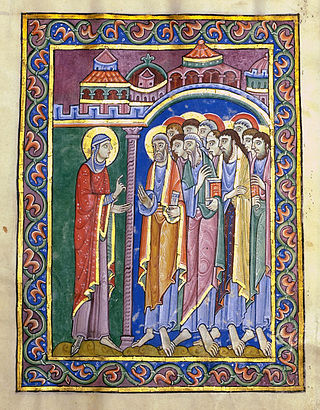
The St Albans Psalter, also known as the Albani Psalter or the Psalter of Christina of Markyate, is an English illuminated manuscript, one of several psalters known to have been created at or for St Albans Abbey in the 12th century. It is widely considered to be one of the most important examples of English Romanesque book production; it is of almost unprecedented lavishness of decoration, with over forty full-page miniatures, and contains a number of iconographic innovations that would endure throughout the Middle Ages. It also contains the earliest surviving example of French literature, the Chanson de St Alexis or Vie de St Alexis, and it was probably commissioned by an identifiable man and owned by an identifiable woman. Since the early 19th century it has been owned by the church of St. Godehard in Hildesheim, Lower Saxony in northwestern Germany, but is now stored and administered at the nearby Dombibliothek in Hildesheim Cathedral. A single leaf from the manuscript is at the Schnütgen Museum, Cologne; one further leaf, and one further cutting, are missing from the volume, their whereabouts unknown.

The Wonders of the East is an Old English prose text, probably written around AD 1000. It is accompanied by many illustrations and appears also in two other manuscripts, in both Latin and Old English. It describes a variety of odd, magical and barbaric creatures that inhabit Eastern regions, such as Babylonia, Persia, Egypt, and India. The Wonders can be found in three extant manuscripts from the 11th and 12th centuries, the earliest of these being the famous Nowell Codex, which is also the only manuscript containing Beowulf. The Old English text was originally translated from a Latin text now referred to as De rebus in Oriente mirabilibus, and remains mostly faithful to the Latin original.
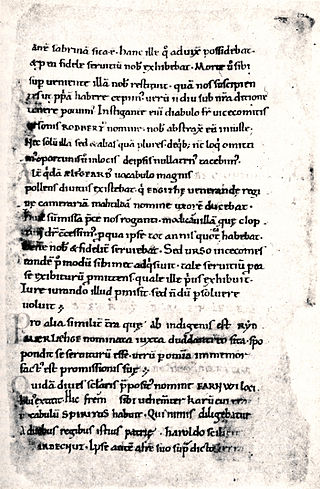
Hemming's Cartulary is a manuscript cartulary, or collection of charters and other land records, collected by a monk named Hemming around the time of the Norman Conquest of England. The manuscript comprises two separate cartularies that were made at different times and later bound together; it is in the British Library as MS Cotton Tiberius A xiii. The first was composed at the end of the 10th or beginning of the 11th century. The second section was compiled by Hemming and was written around the end of the 11th or the beginning of the 12th century. The first section, traditionally titled the Liber Wigorniensis, is a collection of Anglo-Saxon charters and other land records, most of which are organized geographically. The second section, Hemming's Cartulary proper, combines charters and other land records with a narrative of deprivation of property owned by the church of Worcester.

The Eadwine Psalter or Eadwin Psalter is a heavily illuminated 12th-century psalter named after the scribe Eadwine, a monk of Christ Church, Canterbury, who was perhaps the "project manager" for the large and exceptional book. The manuscript belongs to Trinity College, Cambridge and is kept in the Wren Library. It contains the Book of Psalms in three languages: three versions in Latin, with Old English and Anglo-Norman translations, and has been called the most ambitious manuscript produced in England in the twelfth century. As far as the images are concerned, most of the book is an adapted copy, using a more contemporary style, of the Carolingian Utrecht Psalter, which was at Canterbury for a period in the Middle Ages. There is also a very famous full-page miniature showing Eadwine at work, which is highly unusual and possibly a self-portrait.

The Mac Durnan Gospels or Book of Mac Durnan is an illuminated manuscript Gospel book made in Ireland in the 9th or 10th century, a rather late example of Insular art. Unusually, it was in Anglo-Saxon England soon after it was written, and is now in the collection of Lambeth Palace Library in London.

The Anglo-Saxon Chronicle is a collection of annals in Old English, chronicling the history of the Anglo-Saxons.
Oxford, Bodleian Library, MSS Bodley 340 and 342 are two medieval manuscripts kept at the Bodleian Library in Oxford. They date from the early 11th century and contain a collection of Old English homilies in two volumes. From the middle of the 11th century, they were kept in Rochester, Kent. They are particularly notable for containing medieval pen trials by monks from Normandy, Flanders, Germany, and Italy, including the Old Dutch poem known as Hebban olla vogala.